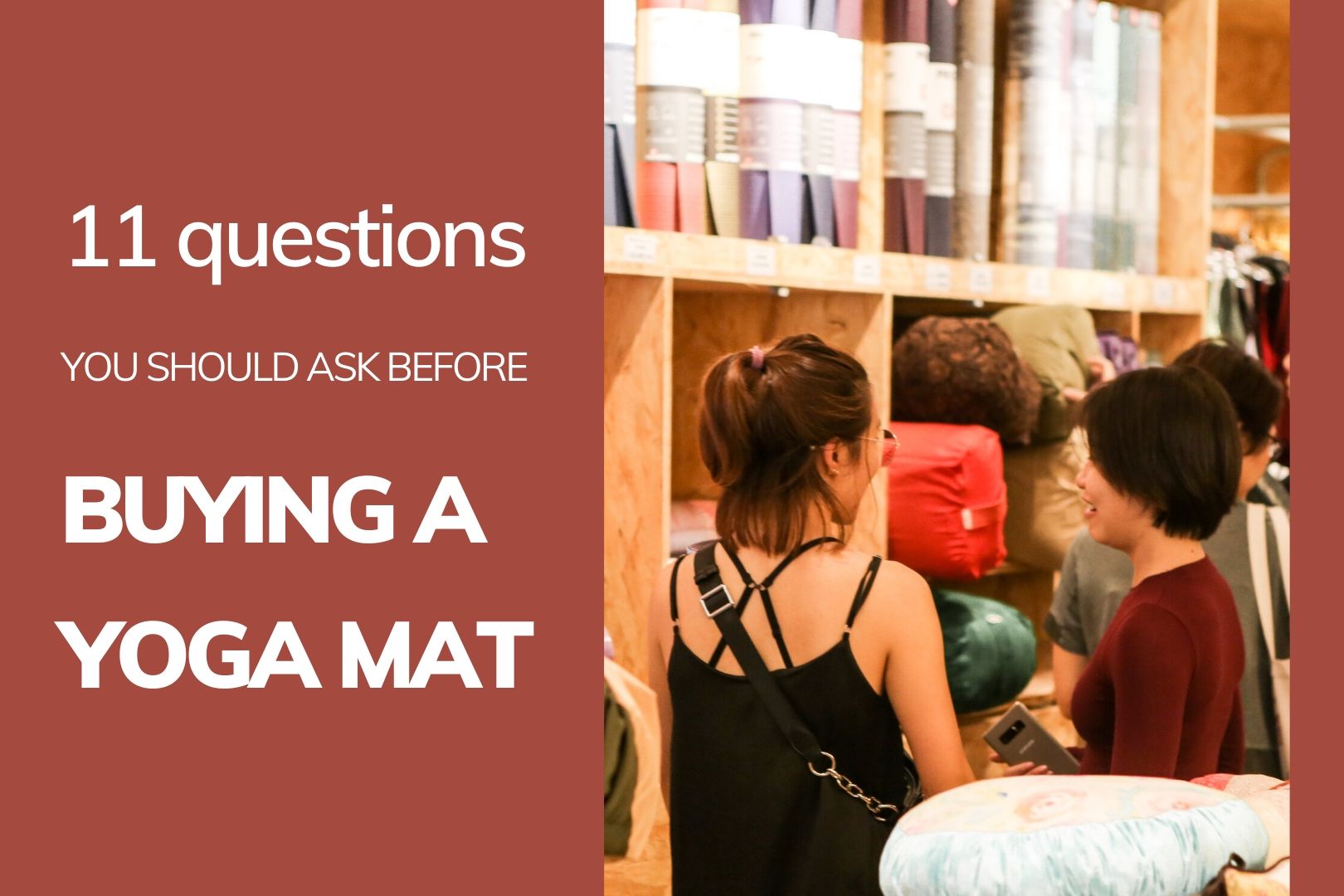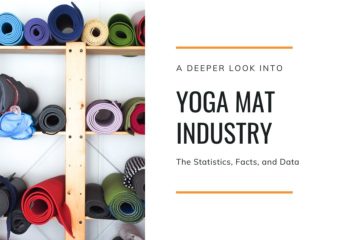When was the last time you bought a pair of shoes? Did you spend some effort to look for them? You did, right? Buying a yoga mat is like buying a pair of shoes. We need to put an amount of effort into researching and finding the one that fits us the most, especially when there are hundreds of different yoga mats.
Even if you have been practicing yoga for years, you might be surprised that you know quite little about yoga mat indeed. Once you choose the right yoga mat for your practice, you would tell yourself, “I should have bought this mat since the beginning of my yoga journey, like three years ago!”
But never too late. So for those who have not found a soul-mat yet, ask these below questions before buying yourself a new yoga mat.
Summary of Contents
1. How thick should it be?
It is quite common that people think all yoga mats are more or less the same in terms of thickness. But in fact, they are very different. Do you know yoga mat thickness ranges from 1mm to 8mm?
A principle to understand here is that the thicker a yoga mat is, the better padding or cushioning it provides for your practice, hence it is better for your knees, wrists, ankles, and joints. However, if a mat is too thick, you might have difficulty in balancing on the mat due to the bouncing effect of the thick padding.
The most standard thickness of a yoga mat is about 5mm – 6mm. If you do not have any problem with joints, a yoga mat with 4mm – 5mm thickness should be good enough.
2. How portable should it be?
Another way to ask this question is “how heavy a yoga mat should be.” The portability here relates to weight, which is important for those who are highly mobile, moving from places to places.
A yoga mat can range from 0.1kg to 5kg. Would you like to carry a 4kg yoga mat for a 15-minute walk or carry it with you for an overseas trip? A high chance is that your 4-kilo yoga mat will mostly stay in one place and hardly get out of the house. Unless you are after a hardcore muscle training by carrying this 4-kilo yoga mat back and forth every day, you should not buy a yoga mat that weighs more than 3 kilos.
3. How much do I sweat?
If you tend to sweat (a lot) during your yoga practice, an ordinary yoga mat will not help you so much. You will probably need a “sticky grippy” yoga mat. You can look for natural rubber yoga mats or yoga mats layered with PU material. These yoga mats are known for their super sticky feature that prevents you from slipping during the Downward Dog or Warrior poses.
You can also consider buying a hot yoga towel to place on top of a regular yoga mat. However, it is not always convenient to bring both a yoga mat and yoga towel for every practice.
So instead of buying both yoga mat and yoga towel, you should probably consider investing in a high-quality natural rubber yoga mat that can solve your slipping problem.
4. What size of a yoga mat is the best for me?
“All yoga mats have the same size.” Is that what you think? If everyone has the same height and size, there is no need to produce different sizes of yoga mats. In reality, that is not the case.
The standard size of a yoga mat is approximately 172cm x 61cm (68” x 24”). Some people find it too short, and some find it too narrow. So longer mats and wider mats are produced to meet their needs. If you are a taller person (above 1.75m), you might consider a mat with a length of 182cm and above. Some yoga mats have a length of 2 meters.
If you are not so tall, don’t go for a longer mat. It will take more space and weight unnecessarily.
5. Should I care about the appearance or the design of a yoga mat?
It is easy to be attracted to something new and trendy. But remember the saying from Coco Chanel, “Fashion changes, style endures.” A classic yoga mat is enough. It does not need all sorts of printed designs that might distract your yoga practice.
Some might disagree at this point. That is fine. If you find a design of a mat absolutely adorable, like love at first sight, and you can’t practice without it, go with your feeling. It will probably motivate you to practice yoga more, at least for the first six months.
Otherwise, choose a plain simple yoga mat with a color that you feel connected with and help you to stay calm and go inwards.
6. What kind of material do I want for my yoga mat?
The majority of yoga mats are made of PVC (Polyvinyl Chloride), which is a form of plastic. This PVC material can be of low quality or high quality. The advantage of PVC is usually durability and affordability. However, it might not be the best choice for those who need optimal grip.
A large number of mats are made of TPE (thermoplastic elastomer), which is called thermoplastic rubber. The advantage of TPE is lightweight and good grip. However, it is usually too soft and not durable. Its lightweight also causes a problem of “floating” on the floor.
An increasing number of mats are made of natural materials, such as natural rubber, jute, cork. Amongst them, natural rubber yoga mats are the most popular and highly recommended. The advantage of natural rubber mats is its grippy nature and its density level, which helps the mats stay grounded on the floor. Some natural rubber mats are also bio-degradable, which is a better and greener choice for our planet.
The mats made from jute or cork are a great choice too. However, jute mats are not the best for grip, and cork mats deteriorate more quickly than natural rubber mats.
7. How is environmental sustainability important to me?
Ahimsa, one of the Ashtanga teachings, is about non-harm practice in our relationships and our environment. Taking this into consideration, some yoga mat brands (like Jade, Yoloha, Beinks) make an effort to produce socially responsible and environmentally sustainable mats.
If you try to avoid plastic yoga mats, it is highly recommended you choose a yoga mat made from natural materials. It is not just a better choice for your practice, for our planet, but also it would help keep you connected with good energy from the mat.
The fact that natural rubber yoga mats are getting much more popular in recent years is also because natural rubber is a quickly renewable resource.
Some yoga mat brands, like Beinks, have their yoga mat material sustainably sourced from South East Asia (mainly from Thailand, Vietnam, Philippines, and Indonesia). In normal conditions, natural rubber is collected from rubber trees for about 30 years. After that, rubber trees from these local farms will be cut down for the use of wood, and new trees will be planted in original places. It is considered the best way for the sustainable growth of natural resources from agriculture.
On another note, some natural rubber yoga mats are biodegradable, which means they will decompose naturally after 3 – 5 years in typical landfill conditions. That will help reduce the amount of waste and give more space on our planet.
8. How easy should it be for me to maintain and clean a yoga mat?
Certain mats get stained quickly and require special cleaning solutions. You don’t want to practice on a stained mat, but you also don’t want to clean your mat every time you practice. It can be quite time-consuming and it might discourage you from rolling out the mat for the next practice.
If you practice almost every day and most of the time outdoor, you should choose a yoga mat that can be cleaned easily without so much of hassle.
9. How patient am I?
Some mats can be at its best right after you open the packaging. However, some mats (known as performance mats) require a “warm-up” or “break-in” period, which can last from a few months to a year.
If you are not a patient kind of person, this type of performance mat might not be for you. You would appreciate a TPE or natural yoga mat much more.
But if you are not in a rush to force your mat to perform its best right away, a performance mat like b’ROCK yoga mat (by Beinks) or Pro mat (by Manduka) could be a good choice. The more you practice on these mats, the better it will become later (a few months to a few years later).
10. How much should I spend on a yoga mat?
It is, for many people, the most important factor. A yoga mat can cost you from $10 to $1500. It is easy to pick the $10, isn’t it? But don’t do that.
If you are serious about your yoga practice, and you know you continue to practice yoga for the next few years, invest in a high-quality yoga mat. A good yoga mat does not necessarily cost you a fortune. But don’t go for the luxurious and glamorous brands that charge you an unbelievable price for a yoga mat, unless you find some other values in them.
You can buy a high-quality yoga mat with a budget of $60 – $80 for the natural rubber yoga mat line. For a lower budget (and acceptable quality), you can spend $30 – $50 for the TPE line. Considering using it for years, you will find this investment actually not so significant. So don’t hesitate to buy a good yoga mat, but think twice when you want to spend on fashion clothes or fitness attire. Which one is more essential to us, yoga mat, or fitness clothing? You have the answer!
11. Do I really need a yoga mat?
This question should actually be asked the first. Sometimes (or most of the time?) we buy things that we don’t need, or spend money out of our convenience. Ask ourselves if we really really need to buy a yoga mat.
If we know that we only practice once or twice a month, take a beach towel or borrow the mat from someone or use the mat of the studios. If we practice regularly, a few times per week, it is definitely the time to buy a good quality yoga mat to enhance our yoga journey.
If you already have a yoga mat, and somewhere in your mind saying that it might not be the right mat, read this article to find out if you should replace your current yoga mat with a better one.
Conclusion
A yoga mat is an essential thing for most people who are interested in doing yoga. To choose your soul-mat, remember to ask yourself questions about the specifications of the mat (width, size, grip, weight, material), its use & care (break-in time, cleaning), and its production (the material used, sustainable resource). Finally, it is up to you to decide if the mat is worth the price, and you are willing to invest in this soul-mat.




[…] That is it! 8 signs for a new yoga mat. Do you notice any of these signs with your yoga mat? If yes, consider a new one to enhance your yoga practice. And to save you some time for researching on a new good yoga mat, read this article “11 questions you should ask before buying a new yoga mat“. […]
[…] most essential items. Of course, the prices of these mats can vary widely. Some may even cost well over £1,000 pounds. This brings up an important question. How much is too […]